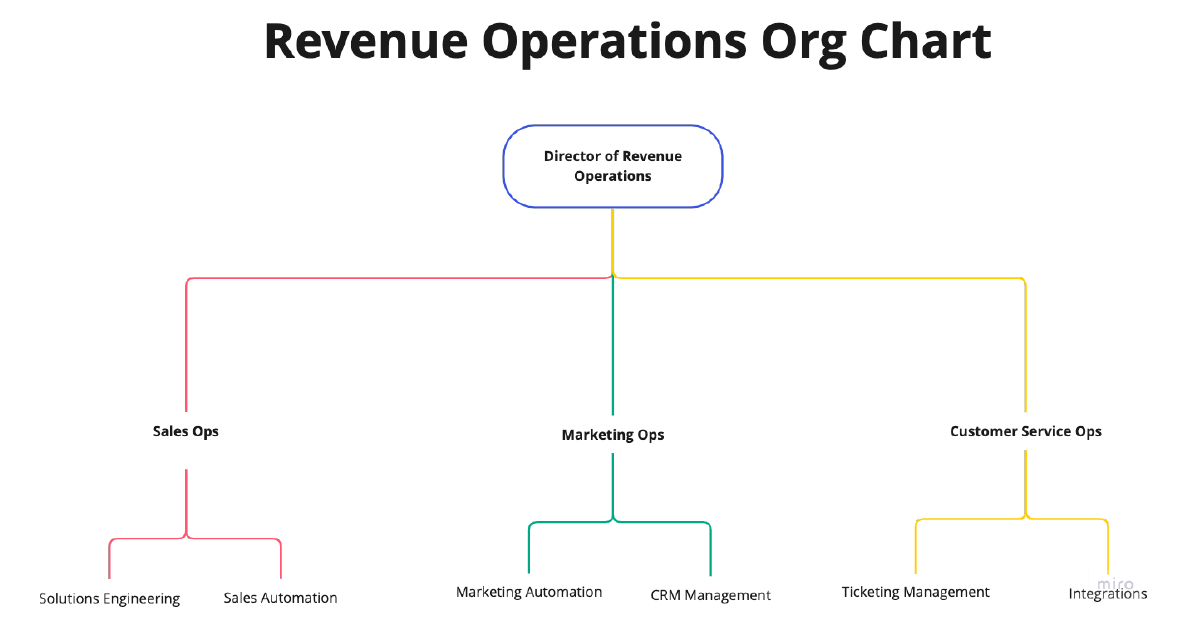As companies grow, they often face the challenge of siloed teams working in parallel, not in tandem (or worse, working against each other). Enter: revenue operations. RevOps for short, this business function ensures that sales, marketing, and customer success teams are aligned and working towards common goals. A revenue operations team can help companies overcome the challenge of siloed departments by providing cross-functional support and creating operational efficiencies. In this article, we will discuss how to build a successful revenue operations team, including samples of RevOps organizational charts and team structures.
- Building a Revenue Operations Team
- Creating an Org Chart for Your Revenue Operations Team
- Developing a Strong Team Structure
- Best Practices for Building a Revenue Operations Team
Building a Revenue Operations Team
Before building a revenue operations team, it is important to assess the structure of your current operation. This includes defining the roles and responsibilities of your sales, marketing, and CS teams, identifying existing and needed skill sets and experience levels, and determining the resources needed to support the creation of a new team. Once you have a clear understanding of your needs, you can begin hiring the right people for your team.
Not all revenue operations teams will look the same. For larger organizations with more budget and stability, an entire revenue operations department might be useful. Directors of Revenue Operations generally oversee operations staff from each of the revenue-generating departments: marketing, sales, and customer support.
While you may already have a marketing ops or a sales ops role, creating a dedicated revenue operations team would mean moving those roles under new leadership, the Head of Revenue Operations.
However, for smaller teams that may want to slowly transition into a dedicated revenue operations team, it may be smarter to hire a consultancy for RevOps or a Head of RevOps that will work cross-functionally with other department heads (ie, CMO, Head of Sales, etc) until the budget and need for an entire revenue operations department arises.
Creating an Org Chart for Your Revenue Operations Team
Creating an org chart for your revenue operations team is important to ensure that key roles and relationships are defined and decision-making hierarchies are established. It’s also a great brainstorming exercise and an easy way to share the creation of a new team with colleagues. This includes mapping out the team’s structure to align with business goals and determining reporting lines to ensure clear communication and accountability.
Using a free organizational chart builder, like Miro, can make this process easy and painless. We used Miro to create the org chart below in just a few minutes.

Developing a Strong Team Structure
Once you have created an org chart for your revenue operations team, and have inter-departmental support for creating this business function, it is important to develop a strong team structure. This includes setting expectations and goals for the team, creating a positive team culture, establishing effective communication and collaboration practices, and providing ongoing training and professional development opportunities.
Much easier said than done! When hiring a Director of RevOps, or your first revenue operations hire, it’s important they are a cultural fit for your organization. What’s more, they should be prepared to invest time into building a team and getting feedback from existing team members.
It’s important to note that revenue operations is a relatively new position and department. Candidates for your open revenue operations positions will not have decades of experience, nor should you expect them to. It’s more important that the person you hire understands your business model, and has the tools and drive to execute a cross-functional plan to drive revenue for your organization.
Best Practices for Building a Revenue Operations Team
Building an effective revenue operations team doesn’t happen overnight. To make sure you are successful in optimizing how your business functions and drives revenue, here are a few best practices to follow:
- Utilize tools and resources that can help streamline the process of building an org chart and creating a team structure.
- Invest in hiring the right people for each role, and look for cultural fit.
- Establish clear goals and expectations for the team, as well as how they should work together to achieve them.
- Provide ongoing training opportunities to ensure everyone on the team is up-to-date with industry trends and best practices.
- Create a system of feedback and open communication channels to ensure everyone is on the same page.
- Set measurable KPIs that can be tracked over time for team performance and progress.
By following these steps, you can ensure your revenue operations team is set up for success and drives revenue growth in your business. With the right team in place and an effective org chart, you will be well on your way to creating a successful revenue operations team.
Check out our other articles with advice and best practices on revenue operations, sales automation, and more:



